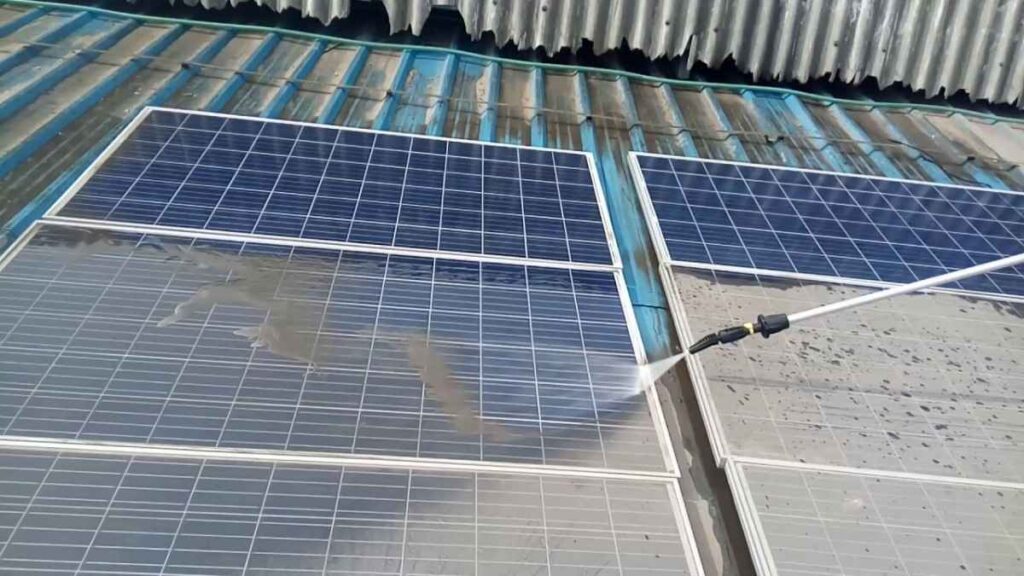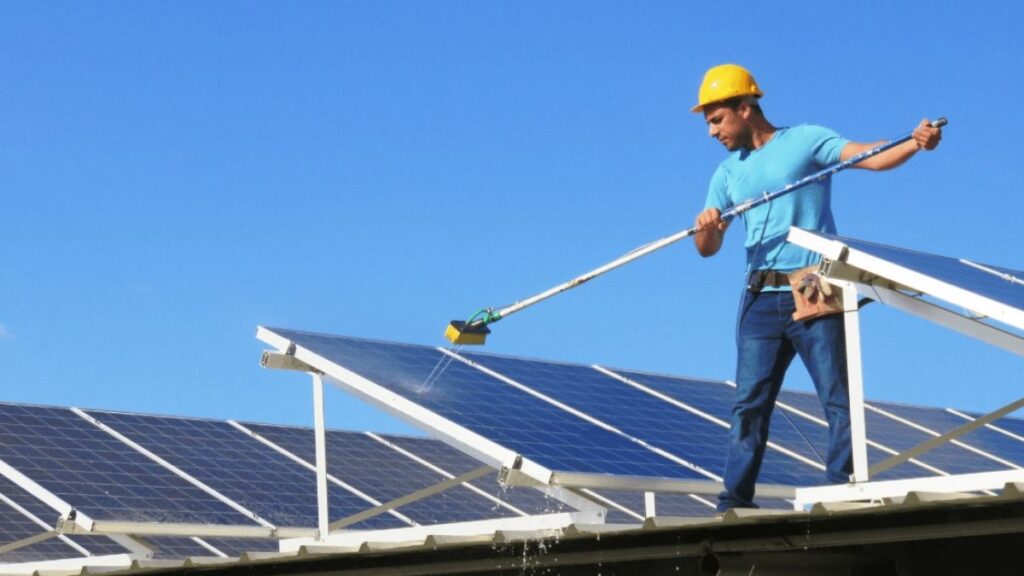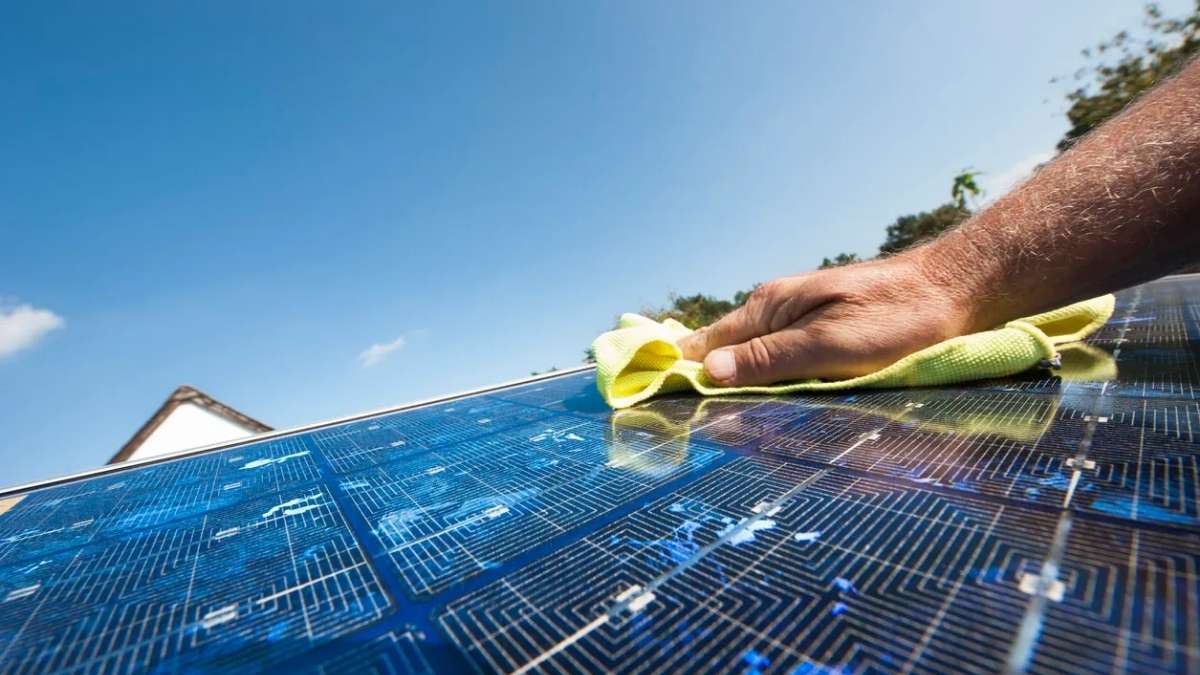Dirty solar panels can significantly reduce energy production, making regular cleaning essential for maintaining maximum efficiency. In fact, factors like dust, bird droppings, and snow accumulation directly impact how effectively solar panels convert sunlight into power. Professional services for how to clean solar panels on roof typically cost between $100 to $300, depending on system size and location.
However, homeowners can save money by learning how to clean solar panels on roof themselves, especially in areas with low rainfall. Additionally, while manual cleaning remains popular, those seeking automated solutions can explore how to clean solar panels on roof automatically with systems ranging from $400 to $1,200.
This comprehensive guide walks through everything needed to maintain clean, efficient solar panels, from essential safety measures to step-by-step cleaning procedures that help maximize energy production.
Why Clean Solar Panels on Your Roof
Solar panel efficiency directly correlates with their cleanliness. Research shows that even light soiling can reduce energy output by 5-10%, with heavy soiling causing losses of up to 20%.
Impact on energy production
The financial implications of dirty solar panels are substantial. For a 150-megawatt solar installation, merely a 1% reduction in power can result in a $200,000 loss in annual revenue. Globally, a 3-4% reduction in power output from solar installations amounts to losses between $3.3 billion and $5.5 billion.
Different environments present varying challenges. In desert areas, dust accumulation is particularly problematic, reducing solar efficiency by approximately 40%. Furthermore, the size of dust particles matters – smaller particles block more radiation on the panel surface, leading to greater power reduction.
Air pollution poses another significant threat. Initially, panels exposed to pollutants for just two months without cleaning show a 6.5% decrease in energy production. Notably, when dust undergoes cementation due to morning dew, it becomes increasingly difficult to remove, requiring more intensive cleaning methods.
Signs your panels need cleaning
Monitoring solar panel performance helps identify when cleaning becomes necessary. Here are key indicators that signal the need for cleaning:
- A sudden drop in energy production of 30-50%
- Visible accumulation of dust, leaves, or bird droppings
- Consistent overheating patterns in panels
- Unexplained decline in electricity generation
Regular monitoring proves particularly important since Google’s research demonstrated that unwashed flat panels experienced a 36% drop in energy production over 15 months. Primarily, areas near highways, factories, and airports require more frequent cleaning due to increased pollution levels.
The impact varies by location and panel positioning. Tilted panels generally fare better than flat installations, as rainfall can naturally clean them to some extent. Nevertheless, an annual professional cleaning has shown to improve energy output by up to 12% compared to panels cleaned only by rainfall.
Essential Safety Steps Before Cleaning
Safety stands as the cornerstone for anyone learning how to clean solar panels on roof. First and foremost, understanding proper safety protocols prevents accidents and ensures successful maintenance.
Required safety equipment
Proper Personal Protective Equipment (PPE) forms the foundation of safe solar panel cleaning. Class 0 gloves, rated for 1000V AC and 1500V DC, serve as the primary defense against electrical hazards. Moreover, Class G hard hats, rated to 2,200V, protect workers during under-array inspections.
Essential safety gear includes:
- Class 0 dielectric boots (rated to 1kV) for electrical protection
- Arc flash harnesses for fall protection above 4 feet
- Electrically insulating gloves for handling panels
- Sturdy, non-slip footwear for secure footing
- Safety helmets for head protection
Weather conditions to avoid
Specifically, certain weather conditions pose significant risks when attempting to clean solar panels on roof. Solar panels can reach temperatures up to 150°F in direct sunlight. Consequently, cleaning during peak sunlight hours increases both safety risks and potential panel damage.
Icy conditions create particularly hazardous situations, primarily through slick surfaces and potential falling hazards. Snow accumulation poses dual risks – reduced visibility and unstable footing. According to safety experts, working in snowy conditions leads to approximately 100 fatalities annually during maintenance activities.
System shutdown procedure
Before learning how to clean solar panels on the roof, proper system shutdown remains crucial. The process involves multiple steps to ensure complete safety:
- Locate and turn off the designated breaker in the electrical panel
- Disconnect the DC switch on the inverter
- Activate the AC disconnect near the inverter or electrical panel
- For micro-inverter systems, turn off breakers in the combiner panel
The U.S. Occupational Safety and Health Administration (OSHA) emphasizes several critical risks, including fall prevention, lockout/tagout procedures, and arc flash hazards. Accordingly, proper system isolation using lockout/tagout procedures must precede any cleaning activity.

How to Clean Solar Panels on Roof: Step-by-Step Guide
Learning how to clean solar panels on roof requires proper tools and techniques to ensure effective cleaning without damaging the panels. Primarily, gathering the right supplies sets the foundation for successful maintenance.
Gathering cleaning supplies
A comprehensive cleaning kit should include:
- A soft-bristle brush with long handle for gentle scrubbing
- Garden hose with spray nozzle (avoid pressure washers)
- Mild, non-abrasive soap or specialized solar panel cleaner
- Soft sponge or microfiber cloth
- Squeegee for water removal
- Bucket for cleaning solution
Basic cleaning process
The optimal time for how to clean solar panels on roof is during early morning or late evening when panels are cool. Subsequently, follow these steps:
- Remove loose debris with a soft brush
- Spray panels with clean, lukewarm water
- Apply mild soap solution with soft sponge
- Gently scrub in circular motions
- Rinse thoroughly with clean water
- Use squeegee to prevent water spots
Indeed, using deionized or distilled water proves most effective, as it prevents mineral deposits that could reduce panel efficiency. For those wondering how to clean solar panels on roof automatically, specialized systems can be installed, although manual cleaning remains cost-effective for residential installations.
Dealing with stubborn dirt
Stubborn stains, primarily bird droppings or cemented grime, require special attention. A solution of one part vinegar to eight parts water effectively tackles tough spots. Likewise, isopropyl alcohol applied with a soft cloth can remove persistent debris.
Therefore, avoid these common mistakes when dealing with stubborn dirt:
- Using abrasive tools or brushes
- Applying harsh chemicals or strong detergents
- Utilizing pressure washers that could damage panels
- Walking directly on panels during cleaning
Although rainwater helps with natural cleaning, regular maintenance ensures optimal performance. Professional cleaning services typically charge between $15-$30 per panel, making DIY cleaning a cost-effective alternative for homeowners learning how to clean solar panels on the roof.
Best Tools and Solutions for Panel Cleaning
Selecting proper equipment stands as the foundation for effectively learning how to clean solar panels on roof. Professional-grade tools ensure thorough cleaning while protecting the delicate panel surface.
Recommended cleaning equipment
The cornerstone of how to clean solar panels on roof involves specialized tools designed specifically for solar maintenance. A comprehensive cleaning kit should include a soft-bristle brush specially designed for solar panel cleaning. Primarily, these brushes feature non-abrasive bristles that protect the panel’s surface while effectively removing dirt and debris.
Essential equipment includes:
- A telescopic extension pole with threaded tip or hook
- Squeegee with premium rubber edge
- Microfiber wash sleeves for gentle cleaning
- Follow-through washing brush with irrigation integration
As a result of extensive testing, deionized or distilled water proves most effective for cleaning, as it prevents mineral deposits that could damage panels over time. In addition to basic tools, professional-grade equipment often incorporates water filtration systems that deliver spot-free cleaning results.
Safe cleaning solutions
Understanding how to clean solar panels on the roof requires careful consideration of cleaning solutions. Essentially, mild, biodegradable soap serves as the safest option. For those wondering how to clean solar panels on roof automatically, specialized cleaning systems offer efficient alternatives, though they require careful selection to avoid panel damage.
Manufacturer-approved cleaning solutions offer several advantages:
- Protection against panel degradation
- Prevention of anti-reflective film damage
- Reduction in water usage
- Environmental compatibility with local water sources
A mixture of one part vinegar to eight parts water proves effective for stubborn stains. Ultimately, Dawn dish soap emerges as a reliable option, offering gentle yet effective cleaning power. For optimal results, any cleaning solution should be thoroughly rinsed to prevent residue buildup that could affect panel performance.
Professional cleaning equipment manufacturers emphasize using water-fed pole systems, which allow cleaners to reach heights up to 30 feet while maintaining firm ground positioning. These systems combine with specialized attachments that enable simultaneous cleaning and rinsing, streamlining the maintenance process.

How to Clean Solar Panels on Roof Automatically
Automated solutions offer a hands-free approach for how to clean solar panels on roof, eliminating the need for manual maintenance while ensuring consistent performance. These systems represent the future of solar panel maintenance, with predictions indicating that over 70% of ground-based solar installations will utilize autonomous cleaning within five years.
Automated cleaning systems
Learning how to clean solar panels on roof automatically begins with understanding available robotic solutions. Modern cleaning robots feature advanced capabilities:
- Autonomous navigation with precision sensors
- Remote control capabilities via mobile apps
- Intelligent scheduling systems
- Waterless and wet cleaning options
- Self-charging mechanisms
Primarily, these systems operate without moving parts or robotic elements, utilizing strategically positioned nozzles for optimal coverage. Rather than requiring constant oversight, automated systems can be programmed to clean during overnight hours, simultaneously protecting panels and maximizing daytime energy production.
Smart sprinkler solutions
For those exploring how to clean solar panels on the roof, smart sprinkler systems present a cost-effective alternative. These systems feature programmable wash and rinse cycles, operating through nozzles positioned every few panels. Markedly, the Heliotex system demonstrates the effectiveness of this approach, running one-minute wash and rinse cycles weekly.
Key features of modern sprinkler systems include:
- Programmable cleaning schedules
- Adjustable nozzle positioning (0 to 360 degrees)
- Water-efficient operation
- Motor protection sensors
- Automatic and manual operation modes
Forthwith, these systems utilize biodegradable cleaning solutions, ensuring environmental compatibility while maintaining panel efficiency. Undoubtedly, the most effective systems incorporate pure, filtered water to prevent mineral deposits and maintain optimal panel performance.
Cost considerations
Understanding how to clean solar panels on roof automatically requires careful evaluation of investment costs. Automated sprinkler systems typically range from Rs 1,200 per piece for basic units. Soon, the initial investment pays off through increased energy production and reduced maintenance costs.
The RST NightWash™ system, for instance, can increase production by up to 30%. Overall, automated systems demonstrate significant advantages:
- Reduced labor hazards
- Minimized rooftop damage
- Adaptability to various panel configurations
- Extended panel lifespan
Presently, installation options include both new construction integration and retrofitting to existing projects. The return on investment typically materializes within a few years through increased energy production and lower utility bills.
How to Clean Solar Panels on Roof Frequently Asked Questions
How to clean solar panels on roof automatically?
Automatic cleaning systems, such as robotic cleaners and sprinkler-based solutions, can effectively remove dust and debris from solar panels without manual intervention. These systems use soft brushes, water jets, or air blowers to clean the surface while preventing damage. Investing in an automated cleaning solution is ideal for large installations or hard-to-reach panels, ensuring efficiency without regular maintenance efforts.
How to clean solar panels on the roof?
To clean solar panels on the roof manually, use a soft brush, mild soap, and water to remove dirt and grime. It is best to clean early in the morning or late in the evening to prevent thermal shock from cold water hitting hot panels. Regular maintenance helps maintain efficiency, and using a hose with a spray nozzle can make the cleaning process easier.
Is it safe to clean solar panels myself?
While it’s possible to clean panels yourself, safety should be your primary concern. If you’re not comfortable working on your roof, it’s best to hire a professional cleaning service. Always follow proper safety protocols and use appropriate equipment.
How much can cleaning improve solar panel efficiency?
Regular cleaning can significantly boost solar panel efficiency. Studies show that cleaning soiled panels can increase energy output by up to 12% compared to panels cleaned only by rainfall. In some cases, heavily soiled panels may see efficiency improvements of up to 20% after cleaning.
